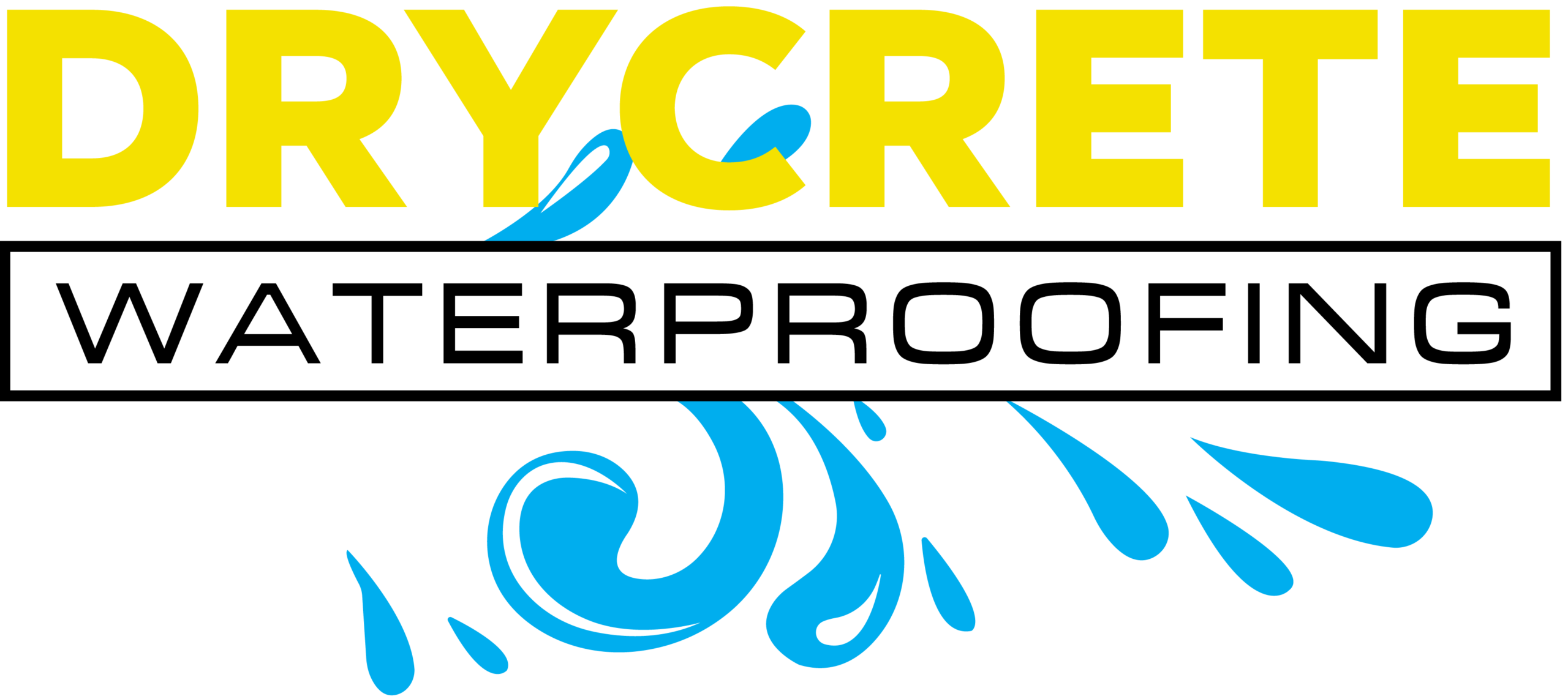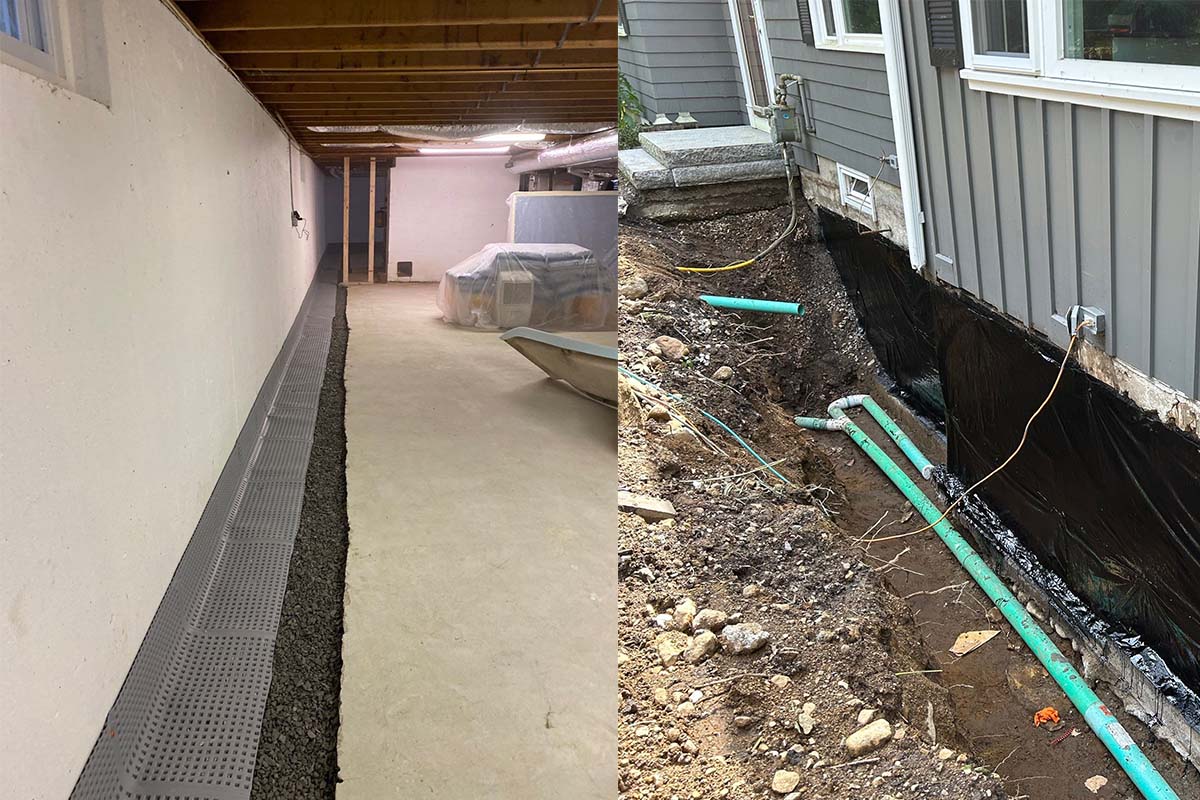Not only does a dank basement take away from the usable space in your home and wreck your stuff, water damage can even threaten the structural integrity of your house. When it comes to waterproofing your basement, there are a variety of methods which can be employed to keep the wet stuff where it should be and away from where it shouldn’t. Some are applied to the outside, some to the inside, and each has its place. When weighing out interior vs exterior waterproofing there are a few factors to consider.
Understanding Basement Waterproofing
Whether it’s interior or exterior basement waterproofing, the aim is basically the same: to keep water from getting into your basement. There are a wide variety of methods which can be employed to this end. Some are relatively simple and unobtrusive whereas others may require heavy equipment and a fair amount of disruption. Which is right for you depends on a number of factors.
Interior vs Exterior Waterproofing
Basement waterproofing falls into two general categories: interior and exterior.
As the names suggest interior waterproofing is work that’s carried out from within your basement while exterior happens outside your foundation walls.
Interior vs exterior waterproofing, which is right for your home will depend on a variety of factors but as a general rule, interior methods are great at dealing with mild-to-moderate problems with a minimum of disruption but will require more upkeep in the long-run.
Exterior systems tend to be rather more drastic but can be employed to deal with really serious problems very effectively.
Exterior Waterproofing

Any system which is applied to waterproof the exterior of your basement walls or on the outside of your home is known as “exterior waterproofing”. Some examples of exterior basement waterproofing would be:
- Wrapping: This involves digging a trench around your foundation to give access and allow a plastic membrane to be “wrapped” around and waterproof the exterior of your basement walls.
- Drains: An exterior French drain is basically a drainpipe which is laid horizontally and allows water to flow away more easily, making it much less likely that it will penetrate your basement walls or floor.
- Guttering: Not all basement waterproofing is applied directly to the basement. Ensuring that rain water is diverted harmlessly away from your home is a great place to start.
- Grading: Ensuring that your home is properly graded, or sloped away from your foundation is absolutely vital to keeping your home dry. This is normally done during the building process but remedial work can be undertaken in extreme circumstances.
Benefits:
- Direct Water Management: Exterior waterproofing addresses moisture issues at their source, preventing water from ever reaching the interior walls.
- Structural Protection: By preventing water from penetrating the foundation, exterior waterproofing safeguards the structural integrity of the building more directly than interior solutions, which primarily manage water once inside.
- Mold and Mildew Prevention: Exterior methods reduce the risk of mold and mildew by keeping the basement dry from the outside, offering a more proactive solution than interior methods that deal with moisture after it has entered.
- Enhanced Property Value: A home with an externally waterproofed basement is often more appealing to buyers than one with just interior waterproofing, as it suggests a more thorough approach to moisture management and structural protection.
- Longevity: Exterior waterproofing solutions are designed to last for decades, offering a more permanent solution to water ingress compared to some interior methods that may require more frequent maintenance or updates.
Drawbacks:
- Higher Cost: The process of exterior waterproofing is typically more expensive than interior methods due to the extensive labor and materials required, including excavation around the foundation.
- Landscaping Disruption: Unlike interior waterproofing, which is contained within the basement, exterior waterproofing can disrupt your property’s landscaping and require significant restoration work afterward.
- Less Feasible in Certain Conditions: Exterior waterproofing may not be an option for all properties, especially those with limited space between buildings or those with extensive hard landscaping, where interior waterproofing might be the only viable solution.
- Weather Limitations: The exterior waterproofing process can be delayed by adverse weather conditions, making it less predictable than interior methods that can be conducted regardless of weather.
- Time and Disruption: The excavation and application process involved in exterior waterproofing is generally more time-consuming and disruptive to daily life compared to the relatively quicker and less invasive interior waterproofing methods.
Best Case Usage:
Exterior waterproofing is ideal for new constructions, high water table areas, historic buildings, and locations prone to heavy rainfall, offering long-term protection against water intrusion.
Interior Waterproofing

As the name suggests, interior basement waterproofing refers to any method which is applied on the inside of your basement to aid in keeping water out. Common systems include:
- Applied waterproofing: Applied waterproofing entails the process of applying specific waterproof materials or coatings to structures to prevent water ingress and protect against moisture damage. Some popular options include:
- Drylock Paints: These are waterproof paints which dry to form a waterproof coating on your basement wall.
- Crystalline solutions: These are applied much like paints but rather than simply sit on the surface, they penetrate and react with the concrete of your basement walls, blocking the tiny cracks and capillaries which can allow moisture in.
- Crack Repair: cracks offer an easy path through your walls for water. Patching and filling these before they spread can be a very effective way of keeping water out.
- Sump Pumps and French Drains: both these methods involve redirecting water away from your home to where it can do no harm.
- Sump Pumps: These sit in a pit installed in your basement floor and physically pump groundwater out of your house.
- French Drains: Think of these as a form of underground guttering. They work by offering water an easier path than coming through your walls.
- Vapor Barriers: these semi-permeable membranes allow vapor to pass through but block liquid. This allows your basement to “breathe” while stopping water finding its way in.
- Dehumidifiers: if condensation is your main concern, a dehumidifier will help by keeping the air in your basement nice and dry.
Benefits:
- Cost-Effectiveness: Interior waterproofing is generally less expensive than exterior waterproofing because it does not require extensive excavation around the foundation of the home, reducing labor and material costs.
- Minimal Disruption: Since the work is carried out inside the basement, there’s minimal disruption to your property’s landscaping, and no need for excavation. This makes the process quicker and less intrusive.
- Feasibility: Interior waterproofing can be implemented in almost any home, regardless of its proximity to neighboring properties or the presence of hard landscaping around the foundation, making it a viable option where exterior waterproofing is not possible.
- Year-Round Installation: Unlike exterior waterproofing, which can be delayed by bad weather, interior waterproofing can be done at any time of year, regardless of external weather conditions.
- Effective Water Management: While it doesn’t prevent water from entering the walls like exterior waterproofing, interior waterproofing effectively manages water by directing it away from the basement space, keeping it dry and usable.
Drawbacks:
- Reactive Approach: Interior waterproofing is a reactive measure that deals with water after it has entered the structure, rather than preventing it from entering in the first place, which can sometimes allow for the possibility of structural damage over time.
- Potential for Humidity: By managing water inside the basement, there can be an increase in humidity levels, which might require additional solutions like dehumidifiers to maintain a comfortable and healthy environment.
- Maintenance Requirements: Some interior waterproofing systems, like sump pumps and interior French drains, require regular maintenance to ensure they continue to function effectively.
- Does Not Address Exterior Water Issues: Interior waterproofing does not mitigate the potential for water to cause external damage to the foundation or alleviate hydrostatic pressure against the foundation walls.
- Limited Structural Protection: While effective at keeping the interior space dry, interior waterproofing does not offer the same level of protection to the foundation’s exterior as exterior waterproofing, potentially leaving it vulnerable to long-term water damage.
Best Case Usage:
Interior waterproofing is best suited for existing buildings where exterior access is limited or excavation is not feasible. It effectively addresses basement moisture issues, helps prevent mold, and protects interiors, making it ideal for urban homes or properties with established landscaping.
Comparing Costs and Longevity
As with any maintenance on your home, there is a value judgement to be made between up-front prices, the lifespan of the system in question, on-going maintenance costs and how long it’s likely to remain effective.
As a general rule, exterior work (with the exception of window-wells and guttering) will last longer and require less on-going maintenance than interior solutions. However, they’re also likely to be considerably more expensive, especially wrapping.
Which option you opt for when you set about waterproofing the basement is up to you but it’s always a good idea to take the time to think seriously and weigh up the pros and cons around costs and longevity of interior vs exterior waterproofing.
Making the decision
Whether you should opt for an interior solution over a course of exterior work will depend on many factors. Each home is unique and therefore requires a unique set of calculations when making your choice.
You should consider:
- Existing water issues in your basement: Are you dealing with a specific problem or trying to head off an issue before it becomes more serious?
- The age of your home: An older home is much more likely to require extensive remedial works to waterproof its basement properly. Over time, hydrostatic pressure and general wear and tear will degrade any systems which are already there.
- How your home was constructed: What is suitable to waterproof a poured concrete basement might not be so perfect for a blockwork wall.
- Your budget: Is it worth stretching your pocketbook to cover more extensive works or will a smaller job meet your needs perfectly well?
Speaking to an expert in basement waterproofing will allow you to make an educated choice between interior vs exterior waterproofing.

